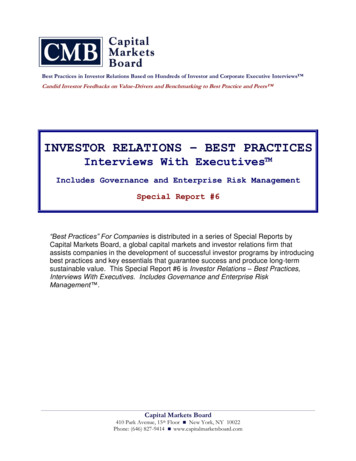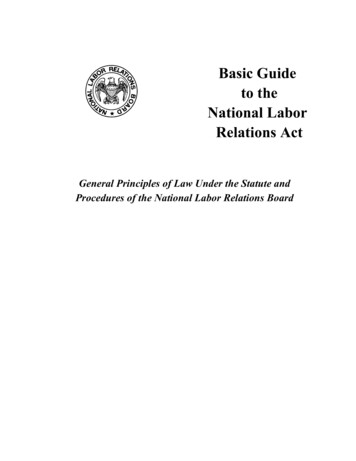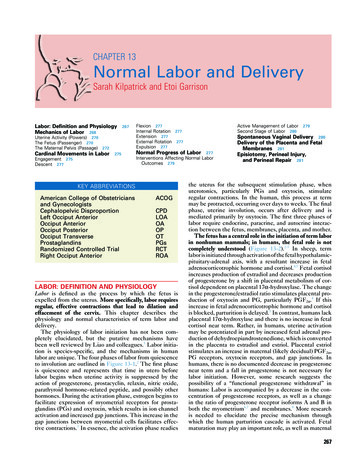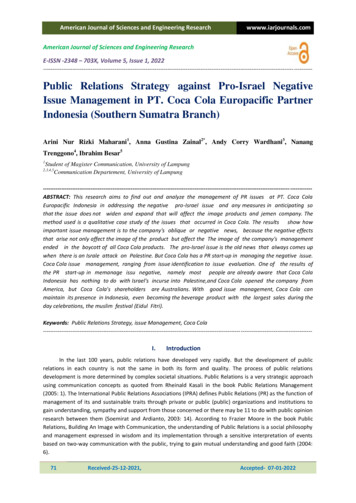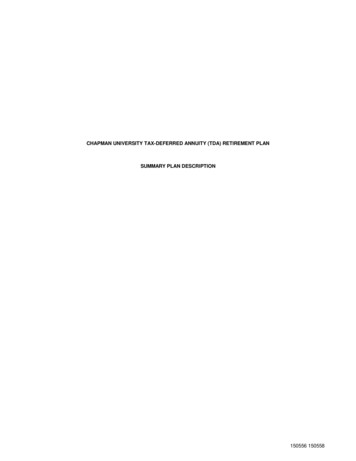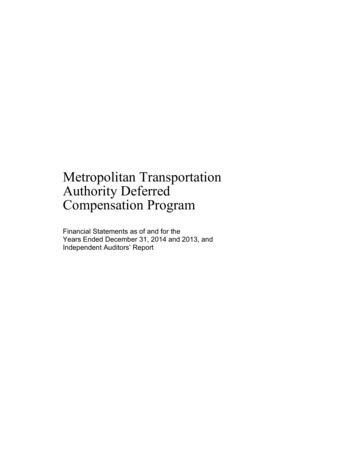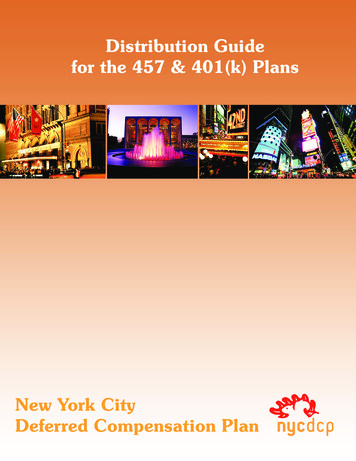
Transcription
Office of Labor RelationsDeferred Compensation Plan & NYCE IRA22 Cortlandt Street, 28th Floor, New York, NY 10007Tel: 212 306-7760 / Outside NYC: 888 DCP-3113 and 888 IRA-NYCEnyc.gov/deferredcomp and nyc.gov/nyceiraBoard MembersMayor of the City of New YorkComptroller of the City of New YorkCommissioner, Office of Labor RelationsDirector, Office of Management & BudgetCommissioner of FinanceCommissioner, Citywide Administrative ServicesPolice CommissionerFire CommissionerUniformed Firefighters AssociationDistrict Council 37, AFSCMECounsel to the Board, Corporation CounselRenee CampionCommissionerDaniel PollakFirst Deputy CommissionerGeorgette GestelyDirector, Employee Benefits ProgramBeth KushnerDeputy Director, AdministrationSang HongDeputy Director, OperationsDear Participant:We are pleased to present you with the New York City Deferred Compensation Plan Distribution Guide. The purposeof this guide is to provide you with information regarding your options for withdrawing funds from your DeferredCompensation Plan account. While this guide contains information on in-service withdrawals, it is largely dedicatedto participants who are leaving or have left City service.The Plan offers very flexible distribution options to help you decide how and when you would like to receive yourmoney, ranging from taking a one-time partial payment to setting up long-term periodic payments that can be deposited directly into your checking account.We have been honored to build a first class retirement program for you over the years which is nationally recognizedas one of the best programs in the U.S. and has among the lowest total fees of any available plan. And with the addition of the Self-Directed Brokerage Option, participants have access to a host of investment funds outside the Plan. So,you can continue to enjoy the many benefits the Plan has to offer and leave your money in the Plan up until you reachage 72 when you must begin minimum distributions.The New York City Deferred Compensation Plan is pleased to now be able to offer the New York City Employee IRA(NYCE IRA) to City employees and their spouses. Outside IRAs charge individual retail rates! In the NYCE IRA,you are not a retail customer. Instead, you are able to continue investing in DCP’s low cost investment options andportfolios, make contributions of earned income and roll over other employer plans and IRAs to consolidate your assets. Be sure that your spouse opens a Spousal NYCE IRA to maintain eligibility for all available benefits.This guide explains the variety of distribution choices available to you so that you can make an informed decision about what is best for your personal situation. We also encourage you to attend a Deferred CompensationPlan Distribution Planning Seminar. To attend the free seminar, please call (212) 306-5050 or register online atnyc.gov/deferredcomp.Sincerely,Georgette GestelyDirectorNew York City Deferred Compensation Plan
Table of ContentsIn-Service Distributions.4Participants’ Frequently Asked Questions.5Post-Service Distributions.8Distribution Planning.10Rollovers.11How to Take a Distribution.13Minimum Distribution Requirements.15Beneficiaries.16Single Life Expectancy Table.17The Uniform Table .18Joint Life Expectancy Table.19Participant Distribution Form (Tear off)If you have additional questions after reading this brochure, please contact the Deferred Compensation Plan’s Client ServiceDepartment between the hours of 9 a.m. and 5 p.m., Monday through Friday, at (212) 306-7760.We encourage you to attend a Deferred Compensation Plan Distribution Planning Seminar. To attend the free seminar,please call (212) 306-5050 or register online.Online at nyc.gov/deferredcompPlease Note: This booklet does not constitute the offering of investment, financial, tax or legal advice or other expert advice.The material contained in this booklet is for informational purposes only. You may wish to consult an investment advisor,legal counsel or other expert before reaching any decisions. In addition, the material in this booklet is subject to the termsof the 401(k) Plan for Employees of the City of New York and Related Agencies and Instrumentalities and the DeferredCompensation Plan for Employees of the City of New York and Related Agencies and Instrumentalities and any other applicable federal, state and local laws and regulations. In the event of any conflict between the 401(k) Plan for Employees ofthe City of New York and Related Agencies and Instrumentalities or the Deferred Compensation Plan for Employees of theCity of New York and Related Agencies and Instrumentalities and applicable laws or regulations, then the applicable lawsand regulations shall govern.The New York City Deferred Compensation Plan Distribution Guide is provided to Plan participants in order to satisfySection 402(f) Special Tax Notice of the Internal Revenue Code.All photographic images throughout this brochure: NYC & Company3/2022Tel: 212-306-7760 888-DCP-3113 (Outside NYC) nyc.gov/deferredcomp
In-Service DistributionsGenerally, you may not withdraw funds from the DeferredCompensation Plan while you are still employed by theCity. However, there are certain exceptions which aredescribed below.Trustee to trustee transfers for the purpose of purchasingpermissive service credits457 and 401(k) Plan participants are eligible to use pre-taxfunds in their Deferred Compensation Plan accounts asa source of funding for the purchase of permissive service credits in their pension systems via trustee-to-trusteetax-free transfers. Plan participants who want to purchasepermissive service credits must contact their pensionsystem directly to obtain a buyback statement to determinepermissive service credit eligibility.Once you receive your buyback information from yourpension system, including the dollar amount, you willneed to complete a Deferred Compensation Plan InService Distribution Form. In-Service Distribution Formsare available for download from the Plan’s Web site atnyc.gov/deferredcomp or by calling 212-306-7760. Submitthe In-Service Distribution Form, along with a copy ofthe buyback statement from your pension system, to theDeferred Compensation Plan’s Administrative Office.If purchasing service credit for a pension system outsideNew York State you need only complete the Plan’s Participant Distribution Form requesting a rollover. Paymentwill be made directly to the pension system and not theparticipant.Emergency WithdrawalIn the event you experience circumstances requiring adistribution from your deferred compensation account, youmay apply for an emergency/hardship withdrawal. Thereare separate applications for the 457 Plan and the 401(k)Plan. (Please contact the Plan’s Administrative Office toobtain the appropriate application.) The circumstancesnecessary to qualify for an emergency withdrawal areestablished by the Internal Revenue Service and the rulesfor 457 Plan withdrawals are different than the rules for the401(k) Plan withdrawals. All decisions concerning whatsituations qualify are at the sole discretion of the DeferredCompensation Board.Distribution due to a qualified birth or adoptionEffective January 1, 2020, Plan participants may take an inservice distribution, of up to 5,000 per child per plan, dueto a qualified birth or adoption. Participants are eligible forthe distribution within one year of the birth of the participant’s child or the participant’s adoption of a child who iseither under age 18 or who is physically or mentally incapable of self-support. Such distributions will not be subjectto an early withdrawal penalty. The distribution paymentwill not be subject to mandatory income tax withholdingand will not be eligible to roll over.An in-service distribution due to a qualified birth or adoption made from either the 457 Plan or the 401(k) Planmay be repaid to the applicable Plan, in an amount not toexceed the amount of such distribution. The repaymentshall be treated as a trustee-to-trustee incoming rolloverand payment can only be made in the form of a checkmade payable to the applicable Plan. Contact the Plan forthe necessary form.Small Account WithdrawalYou may receive a full distribution from the 457 Plan priorto severance from City service if all the following criteriaare met:(1) the total account balance does not exceed 5,000;(2) you have not deferred any compensation to your 457account during the two-year period ending on the dateof distribution;(3) you have had no prior small account withdrawal; and(4) you do not have an outstanding loan.Every January, the Plan identifies those participants whomeet the criteria for a small account withdrawal. If you fallinto this category, you will be notified that you may elect toreceive your account in a lump sum distribution. You mayrejoin the Plan at any time in the future.Age 59½ and the 457 PlanIf you are at least age 59½, you may withdraw funds fromyour pre-tax 457 account, even if you have not severedfrom City service. Roth 457 participants, in addition tomeeting the 59½ age requirement, must have made theirinitial Roth contribution more than five years ago if theywish to take a qualified distribution from their Roth 457account income tax-free.Age 59½ and the 401 Plans401(k) Plan participants age 59½ and older are eligibleto take distributions, without penalty, from their pre-tax401(k) account while still working for the City. Roth401(k) participants, in addition to meeting the age requirement, must have made their initial Roth contribution morethan five years ago if they wish to take a qualified distribution from their Roth 401(k) account income tax-freeand without penalty. 401(a) Plan participants can take anin-service distribution starting at age 59½.To receive an in-service distribution, submit the attachedDistribution Form indicating the distribution request is anin-service withdrawal. You can also access your account viathe Plan’s website to request online withdrawals.In-Plan RolloversPlan participants may choose to transfer money from theirPre-tax 457 account to their Roth 457 account or fromtheir Pre-tax 401(k) account to their Roth 401(k) account,subject to income taxes, while still employed by the City.- Page 4 -
Frequently Asked Questions About DistributionsPlease refer to the In-Plan Transfer Form for additionalinformation and instructions.LoansActive employees may apply for a loan from their DeferredCompensation Plan accounts. Please refer to the Plan’sLoan Guide for details and rules. Loans are available onlyfrom the pre-tax portion of 457 and 401(k) accounts. However, the Roth portion is used to calculate the total amountavailable for loan. For active employees who are age 59½and older, an outstanding loan from either the 401(k) Planor the 457 Plan may be deemed as an in-service withdrawal. Such withdrawal will be subject to all applicableincome taxes.Do I have to decide how to distribute my account once Isever from City service?There are no distribution election requirements upon severance* from City employment and participants can makedistribution requests at any time by submitting a Distribution Form or by accessing their account online. At age 72,however, you must begin taking your separate RequiredMinimum Distribution payments from your 457 and 401(k)accounts.When will I become eligible to begin taking distributions,without a penalty, from my Deferred Compensation Planaccount?If you are a participant in the pre-tax 457 Plan, you maybegin distribution, without a penalty, upon age 59½ orupon severance* from City employment regardless of yourage. Regarding distributions from the Roth 457, these canbe taken income tax-free, provided you are age 59½ orolder, and your initial Roth contribution was made at leastfive tax years ago.If you are a participant in the 401(k) Plan, you may begindistribution upon age 59½ or upon severance* from Cityemployment regardless of your age. Any distributionstaken by a 401(k) Plan participant prior to age 59½ willgenerally become subject to a 10% early withdrawalpenalty. There are several exceptions to the 10% earlywithdrawal penalty, including, but not limited to, distributions (1) made to you after a separation from City servicethat occurred after you have attained age 55, (2) rolled overto an eligible retirement plan or an individual retirementaccount (an “IRA”), (3) made in the event you become totally and permanently disabled, (4) used to pay deductiblemedical expenses, (5) made pursuant to a qualified domestic relations order, (6) due to a qualified birth or adoption( 5,000 per child per plan), and (7) made to your estate orbeneficiaries after your death.Regarding distributions from the Roth 401(k), these can betaken tax-free and without penalty, provided you are age59½ or older, and your initial Roth contribution was madeat least five tax years ago.Am I able to roll over funds from other plans into myDeferred Compensation Plan account?Yes. You are able to aggregate all your pre–tax contributions and earnings from other 401(k) plans, 403(b) plans,401(a), 457 plans and rollover IRAs into the City’s 401(k)Plan or the NYCE IRA. The Roth 401(k) Plan will onlyaccept rollovers from other Roth 401(k) plans. In addition, you can also roll over the taxable portion of yourfinal pension payment/loan from your defined benefit plan(NYCERS, Police Pension Fund, Fire Department PensionFund, BERS, TRS) and eligible union annuity fund (403(a)programs) into the 401(k) Special Rollover Account. The457 Plan can accept rollovers of before-tax and Roth contributions and earnings from other 457 plans only.Can I roll over my Deferred Compensation Plan accountto another retirement plan or IRA?Yes, you can. In fact, you can roll your Plan assets intothe New York City Employee IRA, the NYCE IRA. TheNYCE IRA offers the same high quality investment options as the Deferred Compensation Plan. However, if youare in the 457 Plan, it might not be beneficial to roll assetsover if you intend on withdrawing funds prior to age 59½as there are no early withdrawal penalties in the 457 Plan.We have been honored to build a first class retirement program for you over the years which is nationally recognizedas one of the best programs in the U.S. and has amongthe lowest total fees of any available plan. So, you cancontinue to enjoy the many benefits the Plan has to offerand leave your money in the Plan up until you reach age72, and are no longer with the City, when you must beginminimum distributions.Is there a specific time required by the Internal RevenueService at which I must begin taking distribution?Yes. You are required to begin taking certain minimumdistributions from your deferred compensation account byyour “required beginning date.” Your “Required Beginning Date” is April 1st of the calendar year following the* Severence is defined as retirement or being off City payroll for 45 or more days and does not include leaves of absence such as terminal leave, child care leave,sick leave, unpaid leave, workers’ compensation, etc.- Page 5 -
later of the calendar year in which you attain age 72 or thecalendar year in which you retire from City service.Required Minimum Distributions and certain periodic payments are not “eligible rollover distributions” under eitherthe 457 Plan or 401(k) Plan. (Refer to pages 13 and 15 forfurther explanation.)Are my distributions taxable?Payments made directly to participants will be reported onForm 1099-R in the year when paid. Participants receivingdistributions from the pre-tax portion of the 457 Plan andthe 401(k) Plan are subject to mandatory federal tax withholding, as well as applicable state and local taxes. If youare over age 59½ and elect to receive distributions fromyour pre-tax account as periodic payments (installments),you may be eligible for an annual 20,000 exemption fromNew York State and New York City taxes. Distributionsfrom the Roth portions of the 457 Plan and 401(k) Planare not subject to federal, state or local income taxes if theparticipant is age 59½ or older and the initial Roth contribution was made at least five taxable years ago. Distribution of earnings from the Roth 457 and 401(k) Plan beforeage 59½ or for a period shorter than five taxable years aresubject to all applicable income taxes (Roth 401(k) distribution is also subject to penalties).What if I have an outstanding Plan loan when I severfrom City service?Upon severance from City service, all Plan loans becomeimmediately due and payable. The loan may be repaid bycertified check, bank check or postal money order. Yourloan will be offset automatically, if you are requesting adistribution of your account. If your retirement is due todisability, you will need to complete a separate Loan OffsetForm. Once offset, the outstanding loan amount will besubject to all applicable income taxes and will be reportedon Form 1099-R.Can the value of my account change while I am takingdistributions?Yes. Depending on how your deferred compensation account is invested, the value of your account will be subjectto market fluctuations during your distribution period.Your account continues to have the opportunity to grow foras long as you have money in the 457 Plan or 401(k) Plan.The administrative fees will continue to be deducted fromyour account and any appreciation or depreciation willcontinue to be reflected in your account on a tax-favoredbasis.Once I request distribution, will my account be frozen?No. Your account will continue to be subject to marketfluctuations. Please note that requesting distributions doesnot restrict you from moving your assets among the Plan’svarious investment options. Keep in mind, however, that ifyou elect to have your distribution come from a particularinvestment fund, you must ensure that there is money inthat fund. Otherwise, your distribution payment amountmay be reduced or delayed.If I am currently receiving installment payments, am Ieligible to submit an additional distribution request fora partial withdrawal and still maintain my installmentschedule?Yes. You can request a partial withdrawal by accessingyour account online or by submitting a Participant Distribution Form. A partial withdrawal may not be less than 1,000.Is there a limit on the number of partial withdrawals Ican take in a calendar year using the paper form?You may request up to five (5) partial withdrawals in acalendar year. You will be charged a nominal fee for eachadditional request. The amount of each withdrawal maynot be less than 1,000. There is no limit for online withdrawals.Is it generally advantageous to take a full withdrawaldistribution from the pre-tax portions of the 457 Plan or401(k) Plan instead of installment payments?No. When you take a full withdrawal distribution, your entire deferred compensation account is includible as incomein the year of the distribution. If you take installments, youspread out your tax liability.Is it generally advantageous to rollover my pre-tax 457or pre-tax 401(k) to an annuity held in an IRA afterI leave City service?Probably not. Since one of the main advantages of anannuity is that your money grows tax-deferred, it makeslittle sense to hold one in an account like an IRA, which isalready tax-deferred. Annuities are insurance products andmay charge higher expenses and commissions. In addition, they often have surrender charges which can last from5 to 10 years. While annuities can have options offeringguaranteed income for life, this feature may be best suitedfor individuals who do not have a pension plan.What is the priority for distributions from the Roth 457Plan or Roth 401(k) Plan as compared to a Roth IRA?If a participant takes a distribution from the Roth 457 or401(k) Plan either before age 59½ or before the 5-taxableyear period of participation has been completed, the earnings are subject to all applicable income taxes and penalties(Roth 401(k) only). The Roth 457 and 401(k) accountswill be distributed proportionally among contributions andearnings as opposed to a Roth IRA where distributions arefirst taken from contributions and then from earnings.- Page 6 -
Can I get better returns if I move my money from the Deferred Compensation Plan to outside investments?The performance of the Plan’s funds is competitive with the performance of investments offered outside the Plan. In addition, the Plan’s total asset size has allowed it to utilize separate accounts, which means you may pay less in investmentmanagement fees than you would pay if you bought similar fund shares outside of the Plan. Remember, fees count. Everydollar paid in higher fees reduces your return by that dollar. Before you consider moving your money into any new plan oran IRA, other than the NYCE IRA, where you may be paying higher individual retail rates, you may wish to consult withan investment advisor or tax consultant and compare the applicable surrender fees, mortality and expense risk fees, administrative fees and investment management fees, as well as the initial investment requirements.After I terminate City employment, should I take my money or leave it in the Plan?Leave assets in the457 Plan or rollassets into anotherPlanBENEFITSCONSIDERATIONS There is no tax penalty on withdrawals made before age 59½ onboth pre-tax and Roth portions. At age 59½, you can begin taking withdrawals from the 457 Plan, without penalty, even if youare still working for the City. Rolling over 457 assets to a 401(k), 403(b), or 401(a) planwill mean losing the 457 exemption from the early withdrawal penalty. Extremely low investment management fees and quality investment options competitively chosen and independently reviewedregularly A Self-Directed Brokerage Option which allows participants toinvest in any of over 10,000 mutual funds, including no-load/notransaction fee funds and ETFs Annual 20,000 exemption from NYS and NYC taxes on mostpre-tax periodic withdrawals after age 59½Leave assets in the401(k) Plan or rollassets into anotherPlan Extremely low investment management fees and quality investment options competitively chosen and independently reviewedregularly A Self-Directed Brokerage Option which allows participants toinvest in any of over 10,000 mutual funds, including no-load/notransaction fee funds 10% tax penalty on most withdrawals before age 59½ Rolling over 457 assets to the 401(k) Plan will mean losingthe 457 exemption from the early withdrawal penalty. Annual 20,000 exemption from NYS and NYC taxes on mostpre-tax periodic withdrawals after age 59½ Rollovers accepted from other 401(k), 403(b), 401(a), and 457plans, and from rollover IRAs and final pension payments/loansRoll assets into theNYCE IRA(Both Traditional andRoth available) Ability to continue making contributions post Cityemployment with includible income Ability for spouse to open his/her own Spousal NYCE IRA 10% tax penalty on most withdrawals before age 59½ Rolling over 457 assets to the NYCE IRA will mean losingthe 457 exemption from the early withdrawal penalty. Extremely low investment management fees and quality investment options competitively chosen and independently reviewedregularly Annual 20,000 exemption from NYS and NYC taxes on mostpre-tax withdrawals after age 59½ Rollovers accepted from other 401(k), 403(b), 401(a), and 457plans, and from rollover IRAsRoll assets into a retailIRA Ability to continue making contributions post employment withincludible income Annual 20,000 exemption from NYS and NYC taxes on mostpre-tax withdrawals after age 59½ 10% tax penalty on most withdrawals before age 59½ Rolling over 457 assets will mean losing the 457 exemption from the early withdrawal penalty. Generally higher fees and expenses Investment options may not be competitively selected orregularly reviewed.Purchase annuityin an IRA An annuity generally provides a guaranteed income for life Generally higher fees and expenses, and surrender charges Annual 20,000 exemption from NYS and NYC taxes on mostpre-tax withdrawals after age 59½ Payment amounts can be small. 10% tax penalty on most withdrawals before age 59½ Rolling over 457 assets will mean losing the 457 exemption from the early withdrawal penalty.Take the money Most distributions will be subject to a mandatory 20%federal tax withholding 10% tax penalty on most 401(k) withdrawals before age59½- Page 7 -
Post-Service DistributionsYour Account After You Leave City ServiceYou are not required to begin withdrawing any portion ofyour account until you attain age 72 (see Required Minimum Distributions on page 15 for more information).After your severance from City employment, you may nolonger make contributions to the Deferred CompensationPlan.Employees whose payroll status is Pending Lump SumPayoutIf you have a 457 and/or a 401(k) Deferred CompensationPlan account, an amount equal to your current deferralpercentage will be deducted from your Pending Lump SumPayout as a contribution to your Deferred CompensationAccount(s), subject to the 457/401(k) annual contributionlimit and required payroll deductions, provided that thePending Lump Sum Payout is received by the Plan by thelater of two and one-half months after separation from Cityservice, or the end of the year in which you separated fromCity Service. Any payments received after that time are noteligible for deferral to the Deferred Compensation Plan, inaccordance with IRS regulations. You may wish to increaseyour deferral percentage to take advantage of the Plan’sannual maximum contribution amount.If you wish to have a Deferred Compensation Plan deduction taken from your Pending Lump Sum Payout youcannot submit a distribution request until the deduction iscompleted.If you do not wish to have a deduction taken from yourPending Lump Sum Payout and would like your distribution request to be processed, you must suspend your deferral percentage.You will be eligible for distribution after forty five daysfrom the ceased date indicated on the City payroll system.Aggregating Your Retirement AccountsIn addition, as long as you have a balance in your account,you can transfer money from one investment option to another, and designate or change beneficiaries. Your accountwill continue to be subject to market fluctuations and youwill also continue to receive quarterly statements, newsletters, annual reports, and have the opportunity to attendfinancial planning seminars. The quarterly administrativefees will continue to be withheld from your account whileyou have money remaining in the Deferred CompensationPlan.Will I continue to have flexibility with, or control over, mymoney once I leave City service?Yes. So long as you have money in the Deferred Compensation Plan, you can continue to enjoy the same benefitsyou enjoy now. For example, you can continue to maketransfers among investment options and receive significantprice breaks on management fees through the Plan’s useof institutional funds and separate accounts, breaks youprobably would not be eligible for if you rolled over youraccount to an IRA.Your Income Tax ConsequencesPre-Tax 457 and 401(k) Plan AccountsDistributions from your Pre-tax 457 and 401(k) accountsare classified as either “eligible rollover distributions”(ERD) or “non-eligible rollover distributions.”ERDs paid directly to the participant will be includibleas income in the year distributed and will be reported onForm 1099-R and are subject to the 20% mandatory federaltax withholding.Non-eligible rollover distributions, such as Required Minimum Distributions or certain long-term distributions (seepages 13 and 15 for further explanation), will be includibleas income in the year distributed, will be reported on Form1099-R, and are subject to 10% federal tax withholdingunless you indicate otherwise.The Plan will only withhold state taxes and local taxesbased on the requirements of your state of residency. Allother participants, not subject to required withholding, mayelect state and local taxes by completing the applicable section on the Distribution Form or by accessing their accountonline. Your Form 1099-R will reflect the state of youraddress at the time of your distribution.- Page 8 -You can aggregate your retirement accounts by rolling overall of your other 401(k) plans, 403(b) plans, 401(a) plans,457 plans, and rollover IRAs into the NYCE IRA (w
the Plan's website to request online withdrawals. In-Plan Rollovers Plan participants may choose to transfer money from their Pre-tax 457 account to their Roth 457 account or from their Pre-tax 401(k) account to their Roth 401(k) account, subject to income taxes, while still employed by the City. In-Service Distributions


